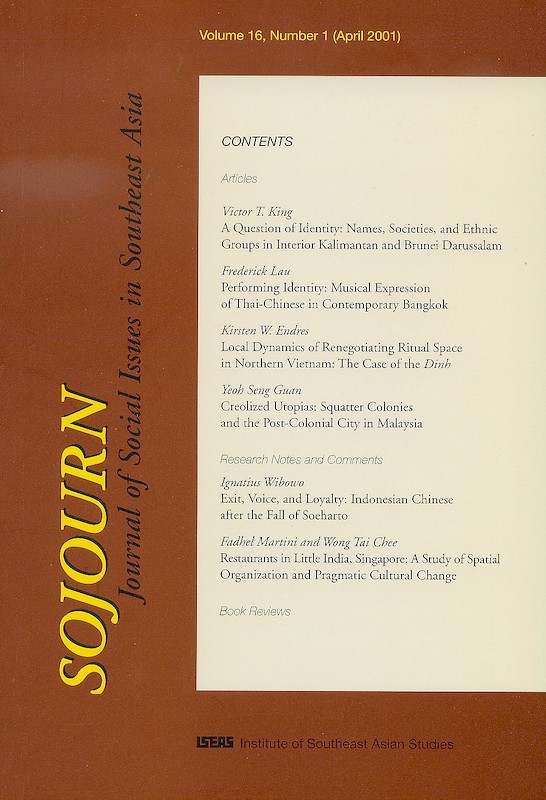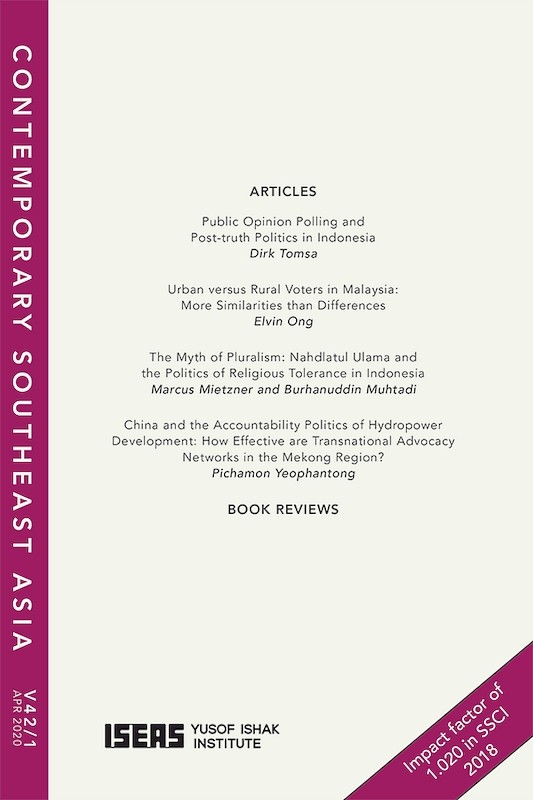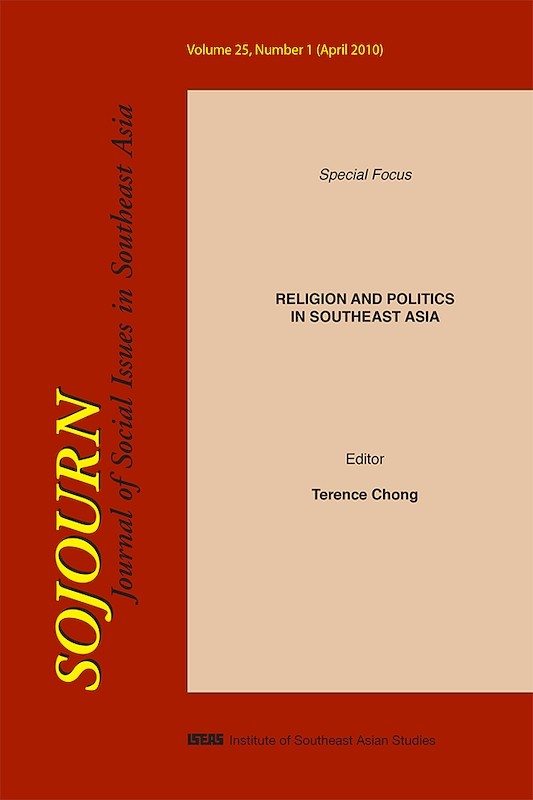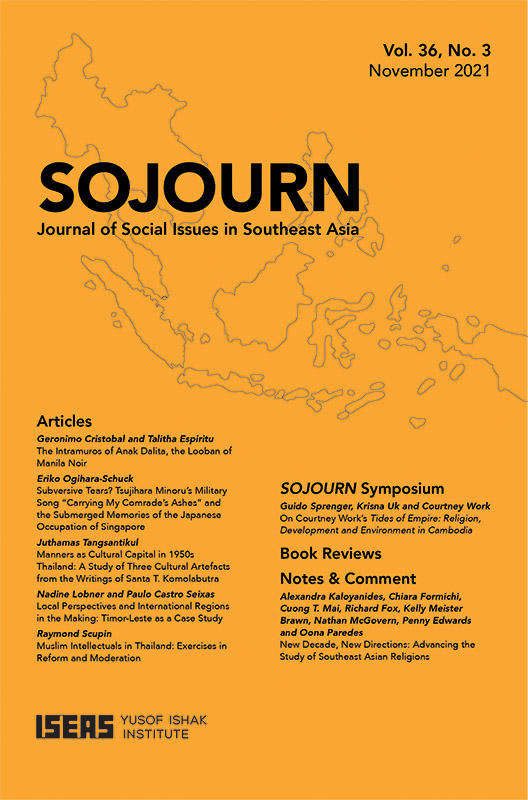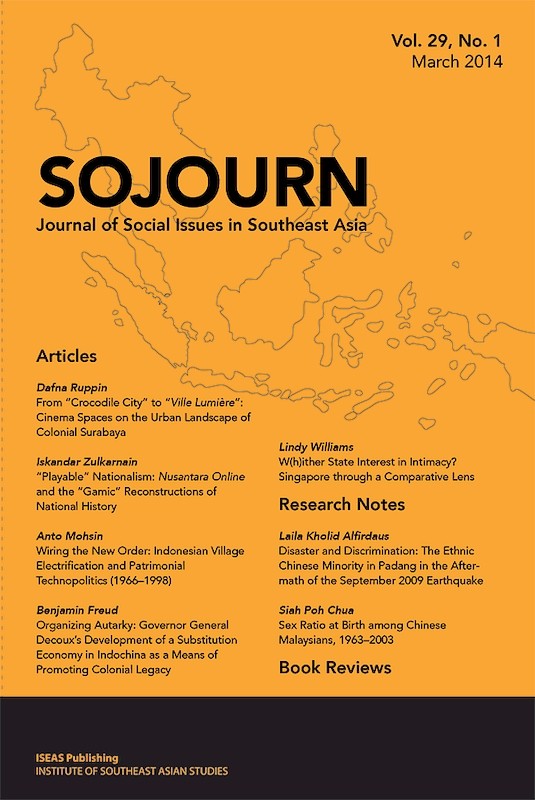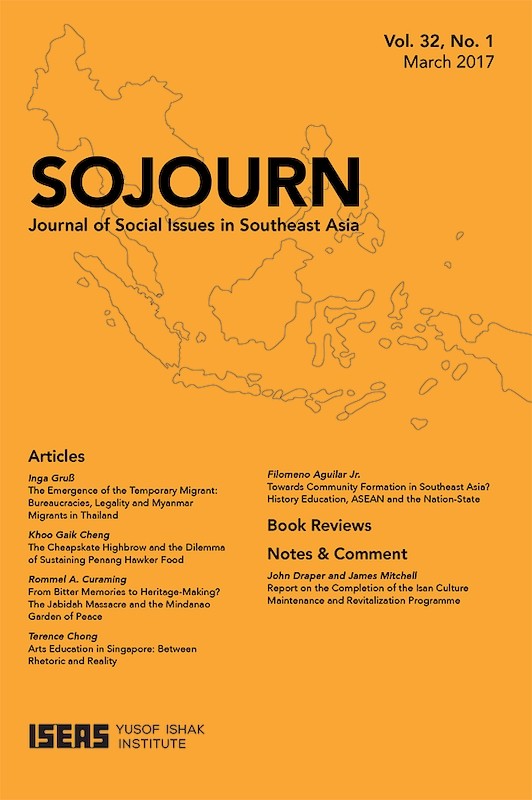SOJOURN: Journal of Social Issues in Southeast Asia Vol. 22/1 (April 2007)

Date of publication:
April 2007
Publisher:
Institute of Southeast Asian Studies
Number of pages:
152
Code:
SJ22/1
Contents
-
SOJOURN: Journal of Social Issues in Southeast Asia Vol. 22/1 (April 2007)
[Whole Publication] -
Preliminary Pages
- ARTICLES
-
Black Areas: Urban Kampongs and Power Relations in Post-war Singapore Historiography, by Loh Kah Seng, author see abstractBy analysing a collection of key texts, this paper examines state-society relations in post-war Singapore in social and spatial terms. It traces the history of state regulation of urban space and a parallel story of resistance by the Chinese population. This paper analyses the making of modern Singapore as a contestation over urban space in the post-war years. A strategic theatre of this struggle was the autonomous Chinese kampongs on the urban periphery. A controlling discourse, representing the urban kampongs as sites of social pollution, made possible the states efforts to eradicate them by relocating their dwellers in public housing.
-
Malaysia's 1996 Education Act: The Impact of a Multiculturalism-type Approach on National Integration, by Noriyuki Segawa, author see abstractThis paper examines how Malaysias 1996 Education Act, which is based on a multiculturalism-type approach, has influenced ethnic polarization in primary and secondary education. This is done through research on the enrolment trend of Chinese Malaysians. Most Chinese have not regarded the Act as an expression of a multiculturalism-type approach but rather as a continuation of the assimilationism-type approach that had been practiced since 1961. This is due in part to many ambiguities in the 1996 Act and in its implementation. The Act has, therefore, not influenced Chinese enrolment trends to any notable extent. The Act and its many ambiguities have not worsened ethnic polarization either nor has it had much impact one way or another on national integration.
-
Memory or Nostalgia: The Imagining of Everyday Bangkok, by Cuttaleeya Naparatnaraporn, Ross King, authors see abstractThe modernization of Thailand has seen an aquatic everyday world replaced by a terrestrial one, and a loose occupancy of land supplanted by Western notions of rigid ownership and title deeds. While the aquatic past passes into memory (to pose some threat, however, to the interests of Thai elites), a Thai episteme based in images and surfaces transforms that memory to less threatening nostalgia and ritual; and the previous fluidity of space likewise survives in surfaces. The study is of three areas of present-day Bangkok that manifest different stages in this transformation to a space of surfaces.
-
Symbolic Power in a Technocratic Regime: The Reign of B.J. Habibie in New Order Indonesia, by Sulfikar Amir, author see abstractThis article examines the technocratic and political influence of B.J. Habibie during the New Order era. His ascendance in power is generally attributed to his relationship to Suharto. This assumption is qualified here, and an attempt is made to identify the sources of Habibies power using Bourdieus concept of symbolic power. Two main aspects are analysed: the symbiotic mutualism between Habibie and Suharto, and Habibies ties with Muslim modernists. The objective is to comprehend how different forms of power are transacted within the political structure of the New Order.
-
The Inculturation of a Transnational Islamic Missionary Movement: Tablighi Jamaat al-Dawa and Muslim Society in Southern Thailand, by Alexander Horstmann, author see abstractThis article analyses the interface between a transnational pietist Islamic movement on the one hand and Muslim villagers in Nakhon Sri Thammarat, Southern Thailand on the other. The Tablighi Jamaat (henceforth abbreviated as TJ) expands at a fast pace, covering nearly every village with their weekly visits. Tha Sala in Nakhon Si Thammarat province is one of their showcases of success, as is Mayo in Patani province. However, the movements efforts to eradicate local tradition tends to divide villagers into supporters and opponents. Concentrating its activities heavily on Islamic rituals, the Tablighi Jamaat tries to disseminate its values locally. Some ardent supporters emerge as new community leaders after having spend long periods of time in India, Pakistan, and Bangladesh in proximity to the Tablighi Jamaats centre, and become brokers who mediate between the movements centre and its local chapters. While the Tablighi Jamaat offers a powerful life alternative to local Muslims, many villagers are uncomfortable with its radical rupture with the past, its neglect of the family, and its escapist attitude towards secular obligations. Tension is expected to rise as the Tablighi Jamaat gains presence and influence.
- BOOK REVIEWS
-
BOOK REVIEW: Rites of Belonging: Memory, Modernity, and Identity in a Malaysian Chinese Community. By Jean DeBernardi, by Lee Hock Guan, author
-
BOOK REVIEW: Transnational Migration and Work in Asia. Edited by Kevin Hewison and Ken Young, by Jerrold Huguet, author
-
BOOK REVIEW: Juggling Money: Financial Self-help Organizations and Social Security in Yogyakarta. By Hotze Lont, by Hans Dieter Seibel, author
-
BOOK REVIEW: The Life of a Balinese Temple: Artistry, Imagination and History in a Peasant Village. By Hildred Geertz, by Margaret Wiener, author
-
BOOK REVIEW: Cultural Politics and Asian Values: The Tepid War. By Michael D. Barr, by Ooi Giok Ling, author

